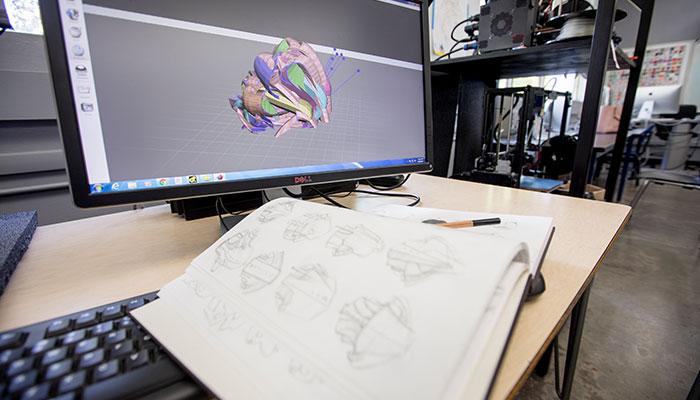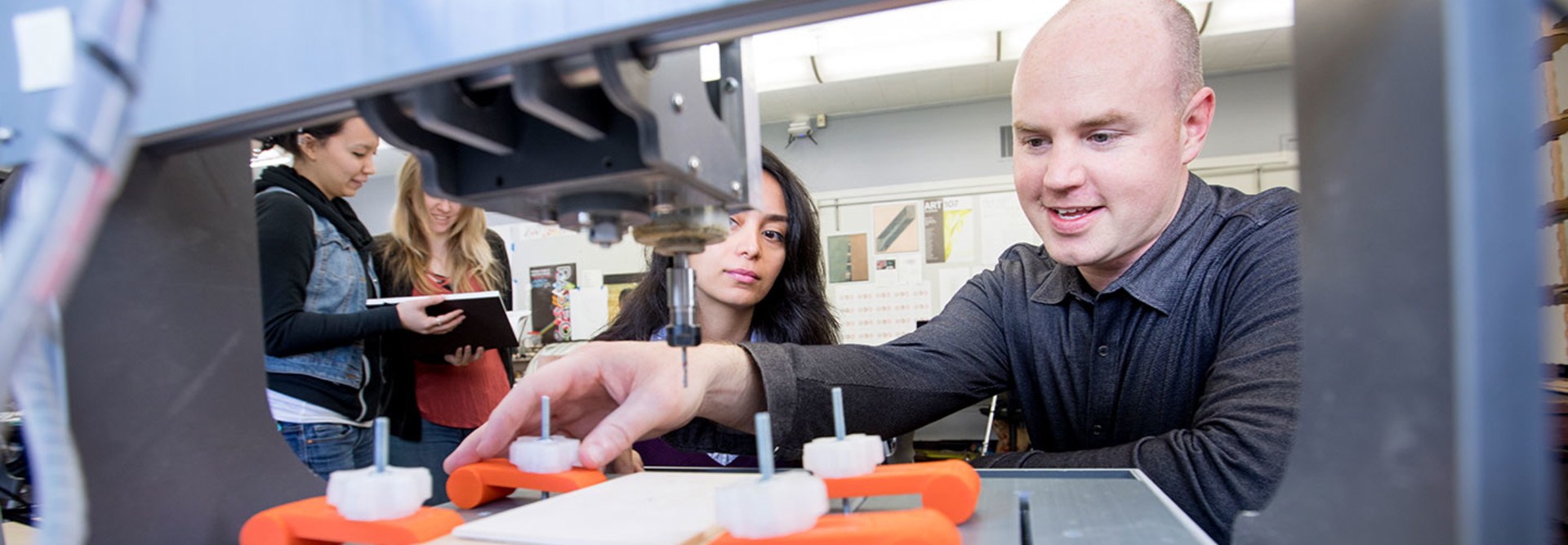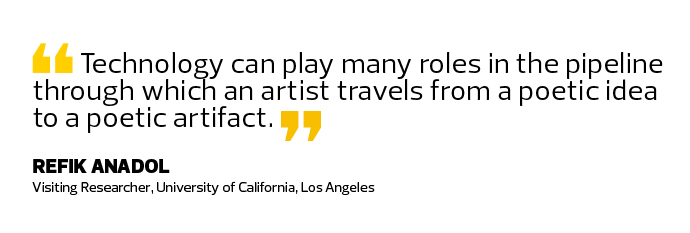Campus Artists Take Inspiration from Digital Media
The notion that a fine arts student might approach technology differently than an engineering student perhaps isn’t surprising. But those differences may not be what you expect, says Andrew Blanton, a professor, musician and media artist at San Jose State University.
“In fact,” he says, “because they’re more inclined to push boundaries than follow rules, art students often leverage technology in ways that your typical engineering student probably wouldn’t.”
As institutions and employers recognize that creativity and technology go hand in hand, they are looking for students who can demonstrate fluency in both arenas. Accordingly, a growing number of fine arts programs are adding a technology component to their curricula. Applications range from complex creations — such as a virtual reality musical theater performance — to groups exploring the marriage of art and computing. The applications, like art itself, are limited only by the imagination.

Digital Tools Add a Layer of Precision
SJSU, located in the heart of Silicon Valley, is ideally situated for digital innovation. Blanton teaches in the university’s CADRE (Computers in Art, Design, Research and Education) Laboratory for New Media Art, where students pursuing fine arts degrees develop multimedia pieces that incorporate elements of art, technology, engineering and entertainment.
“With the right resources, art students can become uniquely empowered to address issues that blur the lines between digital and physical spaces,” Blanton says.
CADRE includes several 3D printers, computer numerical control routers and a desktop laser cutter that are available to digital media students 24/7.

Whereas 3D printers bring precision and control to the creation of sculptural forms using plastic material, CNC routers enable artists to work in wood, metal and stone. The router cuts, bores and shapes those materials based on digital inputs.
Students also have access to popular gaming software and open-source hardware components. These programmable platforms let students create pieces that can register inputs — such as data from a software program, the touch of a button or a social media message — and generate corresponding outputs, such as a change in lighting or movement by a motor. Such high-tech resources complement the art department’s more conventional fabrication capabilities, such as wood and metal shops.
One SJSU student created an award-winning project detailing the steep decline in local bee populations, designing a prototype monitoring station that used flowers to attract bees and infrared sensors to detect activity levels. The resulting data were posted online to create awareness of the issue and encourage public action. Another student recorded a 350-mile bike ride and then created an installation where others could ride a stationary bike while watching the images immersively.
Arts and Tech Foster Career Skills
That kind of innovative thinking is exactly what employers are looking for, says Donna Meeks, who serves as chairwoman of the art department at Lamar University’s College of Fine Arts and Communication. She believes that hands-on experience with the newest technologies gives art students more career options when they graduate.
“Innovative companies are very eager to find young people who are both comfortable with technology and have proved capable of thinking outside the box,” she says. “So our students have options well beyond those that have historically been associated with art majors.” Meeks also points out that familiarity with technologies such as digital animation and 3D printing will be essential for students who pursue teaching careers.
“Anyone who graduates art school today and needs a job teaching art tomorrow must be intimately familiar with these technologies,” she says. “Art is only going to get more digital, not less.”
Refik Anadol, a visiting researcher in design media arts at the University of California, Los Angeles, says that it’s only natural for contemporary artists to embrace technology. “Artists live in the same world as we do, where software and data and sensors are ubiquitous,” he says. “The work of the artist can’t help but reflect this data-driven society.”
The Tech Behind the New Artist's Toolbox
Anadol creates large-scale, immersive installations that use light as a medium. At last year’s InfoComm show, he used Epson Pro L1000 Series laser projectors to create an Infinity Room that mapped four walls with digital art. Such projects can require massive computing power, so institutions are tasked with making as much power available to students as cost-effectively as possible.
UCLA’s solution is an on-premises cloud environment that gives students access to three custom-configured systems anywhere and anytime. Those setups boast quad Nvidia Scalable Link Interface graphics processing units and dual Intel E5-2690 V3 server-grade central processing units, along with RAID 0 disk systems with a peripheral component interconnect express solid-state drive. Networked together, these systems can handle the most processing-intensive graphics programs. Students also have access to fabrication tools: 3D printers, CNC routers and a robotic arm.
At Lamar University, Meeks says that investing in technology for art students, including 3D printers and a wide range of software packages for digital drawing and photo and video manipulation, has also benefitted students in engineering and other departments. Students from multiple disciplines often end up collaborating, she says, which yields a richer educational experience. For example, UCLA’s art students are encouraged to learn at least rudimentary coding so that their work isn’t limited by existing tools and templates.
“Technology can play many roles in the pipeline through which an artist travels from a poetic idea to a poetic artifact,” says Anadol. “Our job as instructors is to help students discover those many roles.”










